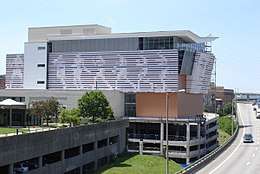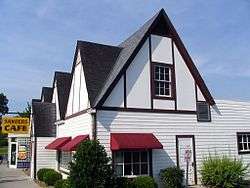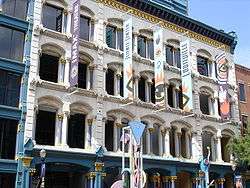Frazier History Museum
Coordinates: 38°15′28.25″N 85°45′52.1″W / 38.2578472°N 85.764472°W
 | |
 Location in Kentucky  Frazier History Museum (the US) | |
| Former name | Frazier International History Museum |
|---|---|
| Established | May 22, 2004 |
| Location | 829 West Main Street, Louisville, Kentucky 40202 |
| Coordinates | 38°15′28″N 85°45′52″W / 38.257727°N 85.764519°W |
| Type | History museum |
| Founder | Owsley Brown Frazier |
| President | Penny Peavler |
| Curator | Brigid Witzke |
| Public transit access | TARC |
| Website |
www |
The Frazier History Museum, previously known as the Frazier Historical Arms Museum and the Frazier International History Museum, is a history museum located on Museum Row in the West Main District of downtown Louisville, Kentucky.[1] An affiliate of the Smithsonian Institution, the Frazier documents and reinterprets stories from history using artifacts, gallery talks, and live daily interpretations by a staff of costumed actors known as “teaching artists.”[2][3][4]
Founded in 2004 as a museum of historical arms and armor, the Frazier later expanded its focus to cover regional, national, and international history.[5][6][7] The museum is home to one of the largest collections of toy soldiers and historical miniatures on permanent public display in the world, The Stewart Collection.[8][9] Subjects of other permanent exhibitions include historical arms and bourbon whiskey.[10]
In 2018, the museum became the official starting point of the Kentucky Bourbon Trail tour.[6][11]
History
Prehistory
Owsley Brown Frazier, a wealthy businessman and philanthropist in Louisville, was an avid collector of historical arms.[12][13] In 2000, the year he stepped down as Vice-Chairman of Brown-Forman, Frazier gave a presentation to the Kentucky Historical Society called “The Art of the Weapon” which spawned the idea for a museum.[12] In 2001, Frazier purchased the building complex at 829 West Main Street.[14] In 2002, a website was launched announcing the “Owsley Brown Frazier Historical Arms Museum,” an institution whose stated mission was “to acclaim the artistry, craftsmanship, and technological innovation of weapons and their makers.”[15]
In February 2003, Frazier signed a formal agreement entering into a partnership with the Royal Armouries Museum in Leeds, also known as the United Kingdom's National Museum of Arms and Armour, an ancient institution of the Tower of London that was originally founded to manufacture armor for the Kings of England.[5] The agreement outlined plans for the Frazier to borrow and display arms and armament on loan from the Royal Armouries.[5][13] It was the first time that a British national museum had engaged in an ongoing collaboration with any organization beyond its shores.[2][5][13]
Construction on the museum started in 2001 and ended in 2003.[16] Mr. Frazier provided most of the funds for the $32 million project or backed loans that were taken out to finance the development.[12][17]
Frazier Historical Arms Museum

The Frazier Historical Arms Museum opened to the public on May 22, 2004.[12]
Its initial collection consisted of roughly 1,500 objects from the personal collection of Owsley Brown Frazier, dating from 1492 to World War I, and approximately 350 objects borrowed from the Royal Armouries, dating from 1066 to the 1960s.[12][17] Included were antique guns, swords, arrows, and other historical arms and armor from Flanders, France, Germany, Italy, and the United Kingdom, as well as life-size tableaux of mannequins and horse figures depicting battle scenes from European history.[12][13]
Frazier International History Museum
In June 2006, the museum was renamed the Frazier International History Museum, a nod to the multinational origins of its collection.[1] That year, the museum received another influx of foreign arms and military artifacts from the Royal Armouries.[5] Over time, however, it began to shift its focus away from war and weaponry and toward more general topics of state, national, and global history.[5] The permanent collection became gradually de-emphasized as the museum moved toward larger, temporary exhibitions.[5]
Frazier History Museum
In 2011, the museum was renamed the Frazier History Museum.[1]
In May 2012, a bronze sculpture of a Japanese warrior riding horseback into battle by Douwe Blumberg entitled Way of Horse and Bow was gifted to the Frazier by actor William Shatner and his wife Elizabeth.[18] In August, the museum's founder and chief benefactor Owsley Brown Frazier died.[6][19]
The last remaining objects on loan from the Royal Armouries were returned in January 2015.[5]
In April 2017, the museum hosted The Hunger Games: The Exhibition, a special exhibition about the dystopian film franchise starring Jennifer Lawrence.[20] A Louisville native, Lawrence, partnered with the Frazier to help promote the exhibition.[20]
Lonely Planet, in naming Kentucky Bourbon Country as one of the top 10 U.S. destinations to visit in 2018, cited the Frazier Museum as a main attraction.[21] In March 2018, the Frazier sold the first 250 bottles of Final Reserve: James Thompson and Brother Bourbon, a whiskey whose 45 years in the barrel made it the most mature bourbon ever bottled.[22]
In August 2018, the Kentucky Bourbon Trail Welcome Center opened on the first floor of the museum.[23] The Frazier thus became the official starting point of the Kentucky Bourbon Trail tour, a project launched in 1999 by the Kentucky Distillers' Association to promote bourbon tourism in the state.[6][11][23]
Operations
Hours of operation are Monday through Saturday, 9 a.m. – 5 p.m., and Sunday, noon – 5 p.m.[24] The museum is closed on Thanksgiving, Christmas Eve, and Christmas.[24] During museum hours, the Gateway Garden and the Kentucky Bourbon Trail Welcome Center remain open to museum visitors and the general public with no cost of admission.[23][25]
The museum rents out its atrium, loft, champagne parlor, boardroom, outdoor park, and rooftop garden for private events.[26]
It is a non-profit organization funded by private donations.[12][14]
Building
Located on Museum Row in the Bourbon District of downtown Louisville, the museum occupies a late 19th century, Chicago-style commercial structure of 100,000 square feet originally called the “Doerhoefer Building.”[27]
Prehistory
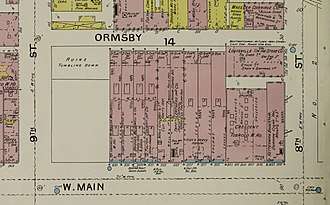
As river-based commerce and trade fueled Louisville's early growth following its settlement in 1779, West Main became the first street established by residents.[29]
Owing to its close proximity to Main Street and the Ohio River, 9th & Main came to serve important commercial purposes. A tobacco warehouse built at the northeast corner of the intersection began operating in the 1850s. The firm of Meguiar, Harris & Co. managed the so-called 9th Street Tobacco Warehouse until the 1890s.[28]
On March 27, 1890, a tornado measuring F4 on the Fujita scale visited Louisville, carving a path from the Parkland neighborhood to Crescent Hill.[30] Labeled "the whirling tiger of the air" by The Courier-Journal, the tornado killed an estimated 76 to 120 people and destroyed 766 buildings, one of which was the 9th Street Tobacco Warehouse.[30]
A rapid reconstruction effort led to the building of more cast-iron façades along West Main between 6th and 9th Streets — the second largest number in the country behind SoHo in New York.[29]
A small item published in the March 23, 1897 issue of The Courier-Journal announced that John Doerhoefer, the president of National Tobacco Works, would build “four handsome business houses at Ninth and Main Streets” on the site of the old 9th Street Tobacco Warehouse.[27][31]
Architecture
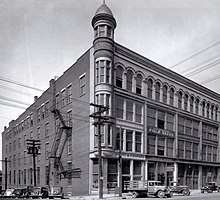
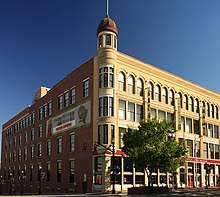
Mr. Doerhoefer hired D. X. Murphy and Bros., the architectural firm that two years earlier had designed the iconic Twin Spires atop the grandstand at Churchill Downs, to draw the plans.[27][32] It was to be made of brick, stone, and iron with a tower at the corner.[27]
Established in 1898 and built of cast iron and yellow-buff brick, the "Doerhoefer Building" was actually built as a complex of four adjoining buildings with common walls and a single façade.[27] As such, the structure spans four typical Main Street fronts (827-833) before it rounds the corner of 9th Street with an oriel topped with a cornice roof.[27]
Each façade is separated by pilasters with simple ornamentation.[27] Machine-made festoons decorate the horizontal bandcourse which divides each major section between the second and third floors.[27] Windows on the fourth floor are separated by brick pilasters, with stone capitals, which continue into arches of radiating bricks with some trim.[27]
Much of the original stone ornamentation has gone missing.[27]
1916 Ox Breeches fire
Around 1906, the self-proclaimed "largest producer of pants in America," Ox Breeches Manufacturing Company, became the majority occupant of the four buildings that now comprise the museum.[33]
During the night of January 6, 1916, a fire broke out on the third or fourth floor of the Ox Breeches factory, causing large scale damage.[33] The story was reported in newspapers from Connecticut to Hawaii, including in Cincinnati's German language paper.[33] The fire completely destroyed the building at 825 West Main Street, leaving a vacant space at what is now the site of the Frazier's vestibule and outdoor park.[33] A Louisville Metro government history of the Louisville Fire Department calls the event "the first major recorded fire in the early 20th century."[33][34]
Charring is still visible on some of the timber joists on the southeast side of the building.[33]
Renovations
In 2001, when Mr. Frazier purchased the complex, he had much of the interior gutted and rebuilt.[17] A copper-topped cupola was installed on the crest of the structure's southwest corner, as the original cupola had been removed sometime between 1936 and 1966.[17]
In 2012, a $700,000 renovation project, funded through grants and public contributions, expanded the museum's exhibit space from 2,700 to 7,500 square feet.[19] The Frazier also purchased 821 West Main Street, a neighboring, four-story brick building of 18,000 square feet.[19]
In 2018, the museum opened a new vestibule and an outdoor park designed by landscape artist Jon Carloftis.[35][25]
Layout
Basement
Objects in the museum's permanent collection are kept in storage in the basement when not on display. Offices and workspaces for security personnel and employees of the collections and exhibits departments are located in the basement.
First floor
Exterior
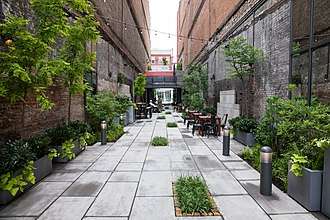
In 2018, the Frazier opened the Gateway Garden, a public park situated at 825 West Main between the museum and the neighboring brick structure to its east.[25]
The park is bordered to the south by the vestibule and to the north by a rolling steel gate on Washington Street.[25] It consists of a linear courtyard populated with native Kentucky plants and furnished with wooden furniture.[25] A staircase at the south end of the courtyard leads to a second-story rooftop garden with a balcony overlooking Main Street.[25]
Interior
Visitors can enter the Frazier from either Main Street or Washington Street.[35] Both points of entry lead to the Cube, a glass vestibule with a front entrance facing Main Street.[25]
Attached to the Cube is the Kentucky Bourbon Trail Welcome Center, a facility that houses the museum's admissions desk.[25] The Kentucky Bourbon Trail Welcome Center abuts the Museum Store, which is located in the southwest corner of the building.[35]
The Great Hall, a large atrium with a sweeping terrazzo staircase, occupies the center of the building.[37] Mounted along its perimeter are low-slung cases featuring highlights from The Stewart Collection organized by theme: “Introduction,” “Local Connection,” “Events as They Happened,” “Evolution of Toy Soldiers,” “Not Just Toy Soldiers,” and “Why Napoleonic?”[38] Southwest of the Great Hall is the Marshall Charitable Foundation Education Center, a classroom where visiting students learn history through hands-on activities.[39]
The north wing (1 North) houses large, temporary exhibitions, as well as the Brown-Forman Theater, a 120-seat auditorium used for live daily interpretations of historical events.[40] Alcoves of the Great Hall, 1 East and 1 West, are used for smaller, temporary exhibits.[41][42]
Second floor
2 South contains the Charles W. Stewart Historic Miniatures Gallery, which houses the hundreds of sets of toy soldiers and historical miniatures from The Stewart Collection that are on public display, and Selections from American History Collection.[38] Low-slung cases around the floor's perimeter include “Revolutionary War,” “Civil War,” and “World War II.”[38]
2 West is a champagne parlor with a bar, Victorian furniture, and Southern Exposition.[43] The mezzanine houses The Founder's Gallery.[44] 2 North is reserved for temporary exhibitions.
Third floor
3 South houses The Spirit of Kentucky exhibition.[45] 3 North houses The Lewis and Clark Experience.[46]
Fourth floor
4 North contains a boardroom and offices for the museum staff.[47] 4 South contains an expansive, New York-style loft with a wooden dance floor, dimmable track lighting, and brick walls lined with 25 windows with plantation shutters.[48]
Rooftop
The rooftop garden features seasonal blooming flowers and looks out across the Ohio River.[49]
Collection
The permanent collection features a wide array of historically significant arms, artifacts of war, and other objects of American, American Indian, Asian, and European origin, most of which were donated to the museum by its founder.[44][50]
Historical arms
Among the oldest firearms in the museum's permanent collection are a Netherlandish or South German snap matchlock target rifle, c. 16th century; a German sporting crossbow, c. 17th century; and an Austrian wheellock rifle, c. 18th century.[50] Other early model firearms include a variety of rifles and handguns made by Collier, Colt, Winchester, Remington, Smith & Wesson, and Marlin during the 19th century.[50]

One of the museum's best-known artifacts is a 1908 Holland & Holland, Ltd. Royal Grade Double Rifle that belonged to President Theodore Roosevelt.[3][13][50] In January 1909, conservationist Edward North Buxton, together with a group of 55 British zoologists and hunting enthusiasts, presented it to Roosevelt, his personal friend, who used it to hunt big game on an African safari.[50] The rifle has acquired the modern, unofficial nickname of "The Big Stick," from Roosevelt's famous quote "speak softly and carry a big stick," which is derived from a West African proverb.[50]
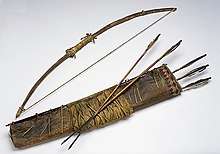
Other arms of notable provenance include Buffalo Bill's lever-action rifle, George Armstrong Custer's ivory-gripped pistols, George Washington's flintlock hunting rifle, Geronimo's bow and quiver of arrows, the James-Younger Gang's revolvers, Josiah Bartlett's saber and scabbard, and a half-stock percussion rifle made by Meshek “Mose” Moxley, a gunsmith who had escaped slavery via the Underground Railroad.[2][3][13][44][50]
Most of the weapons at the Frazier were either manufactured or owned by veterans of American or European military conflicts, including the French and Indian War, the American Revolution, the War of the Second Coalition, the Anglo-Russian invasion of Holland, the Seminole Wars, the Texas Revolution, the Creek Alabama Uprising, the Mexican-American War, the Apache Wars, the Crimean War, the Sioux Wars, and the American Civil War.[50]
Other artifacts
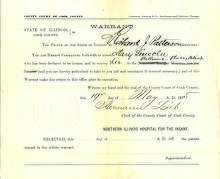
Artifacts of the American Civil War include the First National Confederate Flag, which was likely carried into the Battle of Seven Pines, and the war's oldest remaining monument, which is a stone marker honoring soldiers of the U.S. 32nd Indiana Volunteer Regiment who died at the Battle of Rowlett's Station.[50]
American Indian Wars artifacts include beaded apparel designed for Cheyenne, Lakota Sioux, or Shoshone Indians employed as scouts by the U.S. Army and a surplus marble grave marker from the Battle of Little Bighorn.[50]
Asian and European cultural artifacts in the permanent collection include a battle helmet modified for the Gioco del Ponte games in Medieval Italy, a Japanese jingasa, Samurai suits of armor, and Schützenfest targets.[44]
Among the rare and noteworthy books, documents, and artworks on display are the arrest warrant issued for Mary Todd Lincoln, who was declared “insane” in 1875 and institutionalized; the Boone family bible, a first edition copy of Uncle Tom's Cabin, and an oil painting of Geronimo by Elbridge Ayer Burbank, the only artist for whom the Apache resistance leader ever sat.[2][50][51][52]
Other objects in the collection include ammunition, clothes, dolls, furniture, helmets, jewelry, military uniforms, miniatures, musical instruments, photographs, postcards, statues, textiles, tools, and toys.[44][50]
Exhibitions
Permanent exhibitions
The Founder's Gallery
This exhibition commemorates Owsley Brown Frazier, the museum's founder, with a cast of historically significant artifacts, arms, and implements of warfare drawn from the permanent collection.[44]
The Spirit of Kentucky
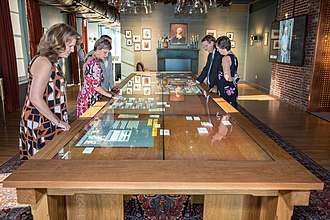
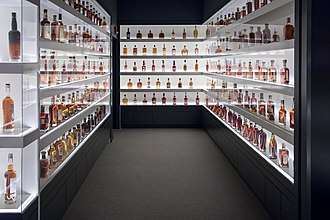
A visual guide to the history, craft, and culture of bourbon whiskey, The Spirit of Kentucky exhibition divides into three themed rooms: Enchanted looks at how the mix of limestone, water, grain crops, and white oak trees in Kentucky promotes bourbon making, Gracious celebrates the camaraderie of bourbon distillers and proprietors, and Refined examines the culture of bourbon consumers and collectors.[55]
Visitors enter through a covered bridge and exit through the Bottle Hall, a corridor stocked with a growing collection of bottles that will ultimately include every brand of bourbon currently being produced in Kentucky.[55]
The Stewart Historic Miniatures Collection
According to Old Toy Soldier magazine, The Stewart Historic Miniatures Collection constitutes “one of the finest collections of rare historic toy soldiers on permanent public display in the world today.”[8][56] It contains over 25,000 figurines, vehicles, and accessories, some 10,000 of which are currently on display, and represents about 130 different makers, including Courtenay, Heinrichsen, Heyde, Lucotte, Märklin, Mignot, M.I.M., Vertunni, and W. Britain.[38][57]
Dioramas in the collection depict scenes from the Punic Wars, the Germanic Wars, the Crusades, the Frankokratia, the Hundred Years War, the Mongol Yoke, the Anglo-Scottish Wars, the American Indian Wars, the American Revolution, the French Revolution, the Napoleonic Wars, the Mexican-American War, the American Civil War, the Franco-Prussian War, the Montenegrin-Ottoman War, the Anglo-Zulu War, the Boer Wars, the Mahdist War, the Anglo-Egyptian War, the Spanish-American War, the Russo-Japanese War, World War I, and World War II.[38][58][59]
Special exhibitions
The Lewis and Clark Experience
This immersive exhibition simulates the Lewis and Clark Expedition, a journey undertaken by the U.S. Army's Corps of Discovery from 1804 to 1806 with the mission of gathering scientific and commercial information about the flora, fauna, and geography of the territory within and northwest of the newly-acquired Louisiana Purchase.[60]
Southern Exposition
A champagne parlor in 2 West doubles as an event space and exhibit about the Southern Exposition, an annual, civic convention in Louisville modeled after the World's Fair which ran from 1883 — when President Chester A. Arthur presided over the inaugural opening ceremony — to 1887.[43][61]
Notable past exhibitions
- British Royal Armouries USA, May 22, 2004 – January 19, 2015. With over 300 European artifacts borrowed from the Royal Armouries Museum in Leeds dating from 1066 to the 1960s, this exhibition featured antique guns, arrows, swords, muskets, and other historical arms and armor from Flanders, France, Germany, Italy, and the United Kingdom, as well as life-size tableaux of mannequins and horse figures depicting battle scenes from European history.[5][12][13]
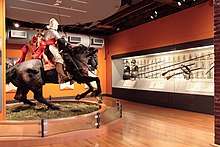 Antique pole arms in British Royal Armouries USA, April 23, 2006.[62]
Antique pole arms in British Royal Armouries USA, April 23, 2006.[62] - Water Works, October 23, 2010 – May 1, 2011. This history of the Louisville Water Company tracked the city's evolution from “Graveyard of the West,” a nickname it earned in the 1800s when its sewage-contaminated wells spread cholera and typhoid, to winning “Best Tasting Tap Water in America” in 2008.[63]
- Da Vinci: The Genius, May 14 – September 18, 2011. Featuring a glider, helicopter, machine gun, model of the “ideal city,” movie camera, parachute, SCUBA gear, tank, and other full-scale machines reproduced from his personal notebooks, this traveling exhibition celebrated Leonardo da Vinci.[64]
- Samurai, May 12 – September 30, 2012. An exploration of the arts and philosophy of the military nobility of medieval and early modern Japan, this exhibition included armor, arms, artworks, religious icons, textiles, and other artifacts of Samurai culture from a period spanning 1,500 years.[65]
- Diana: A Celebration, September 15, 2012 – January 13, 2013. This retrospective on the life and humanitarian work of Diana, Princess of Wales, featured more than 150 of her belongings, including her royal wedding gown, 28 designer dresses, jewels, rare home movies, and personal mementos.[66]
 Original garments on display in Diana: A Celebration, December 4, 2012.[67]
Original garments on display in Diana: A Celebration, December 4, 2012.[67] - Spirits of the Passage: The Story of the Transatlantic Slave Trade, February 2 – June 16, 2013. Produced in partnership with the Mel Fisher Maritime Heritage Museum, this exhibition displayed nearly 150 artifacts salvaged from the Henrietta Marie, an English slave ship that sank off the coast of Florida in 1700.[68]
- Mythic Creatures, May 11 – September 15, 2013. Featuring pre-historic fossils, textiles, paintings, stone carvings, wooden sculptures, and other cultural artifacts, this exhibition on cryptozoology looked at the origins of dragons, kraken, mermaids, Pegasus, phoenixes, unicorns, and other mythic creatures.[69]
- Spirits of the Bluegrass: Prohibition and Kentucky, October 29, 2015 – January 9, 2018. Featuring two full bars and a lighted stage, this exhibition explored the unintended consequences of Prohibition by tracing the rise of the temperance movement, bootleggers, speakeasies, and flappers during the 1920s and '30s.[70]
- The Hunger Games: The Exhibition, April 1 – September 10, 2017. This exhibition explored The Hunger Games dystopian film franchise with set recreations and original maps, props, and costumes, including the Girl on Fire dress, the Mockingjay pin, and Katniss's bow.[71]
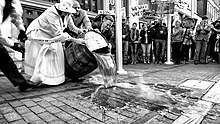 Bourbon is dumped at the opening of Spirits of the Bluegrass, October 29, 2015.
Bourbon is dumped at the opening of Spirits of the Bluegrass, October 29, 2015. - Magnificent Mona Bismarck, March 15 – July 29, 2018. This retrospective on 1930s style icon Mona Bismarck featured garments, hats, shoes, and jewelry designed by Cristóbal Balenciaga, Elsa Schiaparelli, Emilio Pucci, Fulco di Verdura, Hubert de Givenchy, Madeleine Vionnet, and Roger Vivier.[72][73][74]
Interpretations
A staff of costumed actors known as "teaching artists" stage live daily interpretations at the Frazier.[75] The performances cover a breadth of historical material dating from the Middle Ages to the 1930s.[75]
Subjects include legends of Norse mythology and English folklore, the trial of Joan of Arc, the execution of Anne Boleyn, the Golden Age of Piracy, the reign of Catherine the Great, the Whiskey Rebellion, the Burning of Washington, the Blackburn race riots, the sinking of the CSS Alabama, the founding of the Girl Scouts of America, and the kidnapping of an Oklahoma oil tycoon by Kathryn and Machine Gun Kelly.[75]
Stories relayed as firsthand accounts include a sailmaker's captivity aboard the HMS Jersey, a surveyor's incursions into Shawnee hunting grounds, a sharpshooter's missions in the Peninsular War, a riverboat gambler's card games aboard the Kansas Pacific Railway, and a seamstress's achievements in bridal wear.[75]
Selected objects
- Selected highlights from The Stewart Historic Miniatures Collection
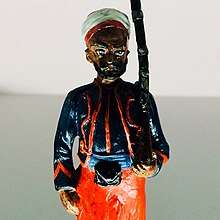 2nd floor, Main Gallery, German Figures, #36: Lineol, Germany, French Algerian Soldier
2nd floor, Main Gallery, German Figures, #36: Lineol, Germany, French Algerian Soldier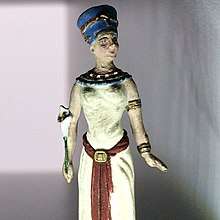 2nd floor, Main Gallery, Various Makers, #54: Courtenay, United Kingdom, Queen Nefertiti
2nd floor, Main Gallery, Various Makers, #54: Courtenay, United Kingdom, Queen Nefertiti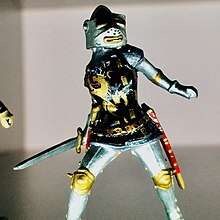 2nd floor, Main Gallery, Various Makers, #50: Courtenay, United Kingdom, Thierry d'Aufay le Hardi
2nd floor, Main Gallery, Various Makers, #50: Courtenay, United Kingdom, Thierry d'Aufay le Hardi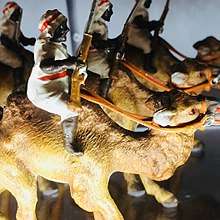 2nd floor, German Gallery, Heyde Figures, #27: Heyde, Germany, Arab Camel Corps
2nd floor, German Gallery, Heyde Figures, #27: Heyde, Germany, Arab Camel Corps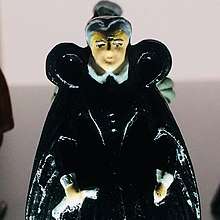 2nd floor, Main Gallery, Various Makers, #9: Vertunni, France, Catherine de Medici, 20th c.
2nd floor, Main Gallery, Various Makers, #9: Vertunni, France, Catherine de Medici, 20th c.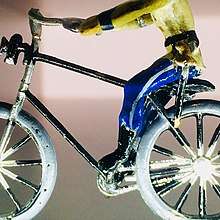 2nd floor, Main Gallery, German Figures, #42: Heyde, Germany, Military Bicycle Troops
2nd floor, Main Gallery, German Figures, #42: Heyde, Germany, Military Bicycle Troops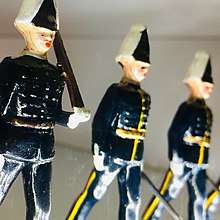 2nd floor, Main Gallery, W. Britain Figures, #44: W. Britain, United Kingdom, Svea Lifeguards
2nd floor, Main Gallery, W. Britain Figures, #44: W. Britain, United Kingdom, Svea Lifeguards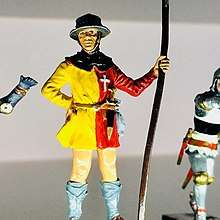 2nd floor, Main Gallery, Various Makers, #50: Courtenay, United Kingdom, Medieval Glaiveman
2nd floor, Main Gallery, Various Makers, #50: Courtenay, United Kingdom, Medieval Glaiveman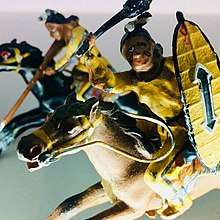 2nd floor, Main Gallery, German Figures, #37: Heyde, Germany, American Indians
2nd floor, Main Gallery, German Figures, #37: Heyde, Germany, American Indians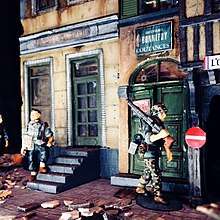 2nd floor, Events As They Happened, World War II: King & Country, Hong Kong, 20th & 21st c.
2nd floor, Events As They Happened, World War II: King & Country, Hong Kong, 20th & 21st c.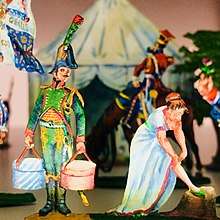 2nd floor, Main Gallery, German Figures, #5: Heinrichsen, Germany, Napoleonic War Flats
2nd floor, Main Gallery, German Figures, #5: Heinrichsen, Germany, Napoleonic War Flats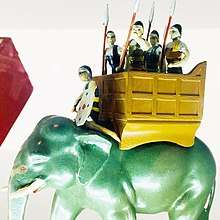 2nd floor, Main Gallery, Various Makers, #29: Minikin, Japan, Hannibal War Elephant, 1950
2nd floor, Main Gallery, Various Makers, #29: Minikin, Japan, Hannibal War Elephant, 1950
See also
References
- 1 2 3 "Charity Review of Frazier History Museum". www.bbb.org. Retrieved 2018-05-14.
- 1 2 3 4 "Frazier History Museum | Kentucky Civil War Sites Association". www.kycivilwarsites.org. Retrieved 2018-05-14.
- 1 2 3 "The Frazier History Museum". C-SPAN.org. Retrieved 2018-05-14.
- ↑ "Visit A Participating Museum For Free on 9/22/18". Smithsonian. Retrieved 2018-05-14.
- 1 2 3 4 5 6 7 8 9 "Frazier Museum returns British armor". The Courier-Journal. Retrieved 2018-05-14.
- 1 2 3 4 "Frazier Museum revamp to extend past bourbon". The Courier-Journal. Retrieved 2018-05-14.
- ↑ Keane, Erin (2014-05-23). "Frazier History Museum Director to Retire | 89.3 WFPL News Louisville". 89.3 WFPL News Louisville. Retrieved 2018-09-04.
- 1 2 "Charles W. Stewart donates toy soldiers, historic miniatures collection to Frazier History Museum in Louisville | The State Journal". www.state-journal.com. Frankfort, KY. Retrieved 2018-05-14.
- ↑ "Toy soldier collection comes to the Frazier History Museum". WHAS11. Retrieved 2018-05-14.
- ↑ "Home". Frazier History Museum. Retrieved 2018-05-14.
- 1 2 "Kentucky Bourbon Trail Welcome Center opens at the Frazier History Museum". Louisville, KY: WDRB. August 30, 2018. Retrieved September 2, 2018.
- 1 2 3 4 5 6 7 8 "Arms and Armor museum opens in Louisville". UPI. Retrieved 2018-05-14.
- 1 2 3 4 5 6 7 "No Title 918 - Kentucky Living". Kentucky Living. 2004-08-01. Retrieved 2018-05-14.
- 1 2 ProPublica, Mike Tigas, Sisi Wei, Ken Schwencke, Alec Glassford. "Nonprofit Explorer - ProPublica". ProPublica. Retrieved 2018-09-04.
- ↑ "OBF Home". 2002-01-08. Retrieved 2018-05-14.
- ↑ "Louisville Downtown Development Plan 2003". University of Louisville. 2002-09-15. Retrieved 2018-09-07.
- 1 2 3 4 5 Shafer, Sheldon S. (2003-11-08). "Frazier arms museum eyes May 22 opening". The Courier-Journal.
- ↑ Keane, Erin (2012-05-15). "Shatner Donates Samurai Statue to Frazier Museum | 89.3 WFPL News Louisville". 89.3 WFPL News Louisville. Retrieved 2018-05-14.
- 1 2 3 "Frazier Museum plans $1.4 million renovation". The Courier-Journal. Retrieved 2018-05-14.
- 1 2 "Jennifer Lawrence holds Power of One Gala at Frazier". WHAS11. Retrieved 2018-05-14.
- ↑ Planet, Lonely. "The best places to visit in the US in 2018 - Lonely Planet". Lonely Planet. Retrieved 2018-05-14.
- ↑ "45-Year-Old Bourbon Scheduled to be Released in March - The Bourbon Review". The Bourbon Review. 2017-12-13. Retrieved 2018-05-14.
- 1 2 3 Jackson, Kyeland (2018-08-30). "Frazier Museum Opens Kentucky Bourbon Trail Welcome Center". 89.3 WFPL News Louisville. Retrieved 2018-09-04.
- 1 2 "Hours, Admission, Directions & Parking". Frazier History Museum. Retrieved 2018-05-14.
- 1 2 3 4 5 6 7 8 "A Lush History". The Voice-Tribune. 2018-07-18. Retrieved 2018-09-04.
- ↑ "Event Spaces". Frazier History Museum. Retrieved 2018-05-14.
- 1 2 3 4 5 6 7 8 9 10 "Four New Buildings". The Courier-Journal. March 23, 1897.
- 1 2 "Image 2 of Sanborn Fire Insurance Map from Louisville, Jefferson County, Kentucky". The Library of Congress. Retrieved 2018-09-22.
- 1 2 "West Main Street: Louisville, Kentucky". American Planning Association. Retrieved 2018-09-21.
- 1 2 "Tiger of the Air: The Incredible Tornado of March 27, 1890" (PDF). Weather.gov. Retrieved 2018-09-21.
- ↑ "Emergency demolition ordered for landmark home". The Courier-Journal. Retrieved 2018-09-04.
- ↑ "Steepled in Racing History : A Century for Churchill Downs' Landmark Twin Spires". The Los Angeles Times. 1995-05-07. Retrieved 2018-09-04.
- 1 2 3 4 5 6 "Retro | Museum recalls 1916 Ox Breeches fire". The Courier-Journal. Retrieved 2018-09-04.
- ↑ "LFD History - Full Text". LouisvilleKy.gov. Retrieved 2018-09-04.
- 1 2 3 "Kentucky Distillers' Association & Frazier History Museum sign contract to create Kentucky Bourbon Trail® Welcome Center & Exhibit - Kentucky Distillers Association". Kentucky Distillers Association. 2017-09-06. Retrieved 2018-05-14.
- ↑ "A Lush History". The Voice-Tribune. 2018-07-18. Retrieved 2018-09-07.
- ↑ "First Floor Great Hall". Frazier History Museum. Retrieved 2018-05-14.
- 1 2 3 4 5 "Stewart Toy Soldier Gallery". Frazier History Museum. Retrieved 2018-05-14.
- ↑ "GoToLouisville.com Official Travel Source". Go To Louisville. Retrieved 2018-05-14.
- ↑ "Daily Live Performances". Frazier History Museum. Retrieved 2018-05-14.
- ↑ "The Great War: Highlights from the Frazier World War I Collection". Frazier History Museum. Retrieved 2018-05-14.
- ↑ "James "Buddy" Thompson Exhibit". Frazier History Museum. Retrieved 2018-05-14.
- 1 2 "Southern Exposition and the Satellites of Mercury". Frazier History Museum. Retrieved 2018-05-14.
- 1 2 3 4 5 6 "Founder's Gallery". Frazier History Museum. Retrieved 2018-05-14.
- ↑ "Upcoming Exhibitions". Frazier History Museum. Retrieved 2018-05-14.
- ↑ "The Lewis and Clark Experience". Frazier History Museum. Retrieved 2018-05-14.
- ↑ "Board Room". Frazier History Museum. Retrieved 2018-05-14.
- ↑ "Fourth Floor Loft". Frazier History Museum. Retrieved 2018-05-14.
- ↑ "Rooftop Garden". Frazier History Museum. Retrieved 2018-05-14.
- 1 2 3 4 5 6 7 8 9 10 11 12 Karcheski, Walter J. (2003). Selections from the Frazier Historical Arms Museum. Lawrenceburg, IN: The Creative Company.
- ↑ "Frazier International History Museum | AMERICAN HERITAGE". www.americanheritage.com. Retrieved 2018-05-14.
- ↑ "Antiques Roadshow | PBS". Antiques Roadshow | PBS. Retrieved 2018-05-14.
- ↑ "The Spirit of Kentucky bourbon exhibit opens at Louisville's Frazier History Museum – Lane Report | Kentucky Business & Economic News". www.lanereport.com. Retrieved 2018-09-07.
- ↑ "The Spirit of Kentucky bourbon exhibit opens at Louisville's Frazier History Museum – Lane Report | Kentucky Business & Economic News". www.lanereport.com. Retrieved 2018-09-24.
- 1 2 Meiners, Simon (2018-09-04). "The Spirit of Kentucky bourbon exhibit opens at Louisville's Frazier History Museum". The Lane Report. Retrieved 2018-09-04.
- ↑ "Frazier History Museum will unveil its expanded toy soldier gallery on Tuesday - Insider Louisville". Insider Louisville. 2016-09-24. Retrieved 2018-05-14.
- ↑ Stevens, Ashlie (2016-09-27). "Frazier's New Toy Soldier Gallery Puts History In The Hands Of Visitors". 89.3 WFPL News Louisville. Retrieved 2018-05-14.
- ↑ "Stewart Collection Photos". Frazier History Museum. Retrieved 2018-05-14.
- ↑ Kremer, Deborah Kohl (2017-11-02). "Tiny Wonders". kentuckymonthly.com. Retrieved 2018-05-14.
- ↑ "Lewis and Clark Expedition | History, Facts, & Map". Encyclopedia Britannica. Retrieved 2018-05-14.
- ↑ "Frazier Museum presents The Southern Exposition". kentuckymonthly.com. 2015-08-24. Retrieved 2018-05-14.
- ↑ "Historic Enterprises Journal No: 5 - September 2005". www.historicenterprises.biz. Retrieved 2018-09-07.
- ↑ "Frazier Museum hosting World Water Day March 22 - Insider Louisville". Insider Louisville. 2011-03-14. Retrieved 2018-05-14.
- ↑ "'Da Vinci: The Genius' at the Frazier History Museum: A must see - Insider Louisville". Insider Louisville. 2011-08-12. Retrieved 2018-05-14.
- ↑ "Frazier History Museum exhibition unlocks the mysteries of the ancient samurai". Retrieved 2018-05-14.
- ↑ "Diana exhibit closes at Frazier Museum". WLKY. 2013-01-13. Retrieved 2018-05-14.
- ↑ "Diana exhibit closes at Frazier Museum". WLKY. 2013-01-13. Retrieved 2018-09-07.
- ↑ Yost, Mark (2013-02-06). "Human Transactions". Wall Street Journal. ISSN 0099-9660. Retrieved 2018-05-14.
- ↑ Keane, Erin (2013-05-14). "Frazier Museum Exhibit Explores Natural History, Science, Folklore Behind Mythic Creatures | 89.3 WFPL News Louisville". 89.3 WFPL News Louisville. Retrieved 2018-05-14.
- ↑ "Prohibition & Kentucky On Display at the Museum of Whiskey History". Boomer Travel Patrol. Retrieved 2018-05-14.
- ↑ "Photo Diary: Frazier History Museum, Louisville KY". Daily Kos. Retrieved 2018-05-14.
- ↑ Suhrawardi, Rebecca. "Couture and Kentucky: Magnificent Mona Bismarck Opens At The Frazier History Museum". Forbes. Retrieved 2018-05-14.
- ↑ Feitelberg, Rosemary (2018-03-19). "Kentucky Countess Mona Bismarck's Couture Wardrobe, Designer Friends and Artist Admirers". WWD. Retrieved 2018-05-14.
- ↑ "The South's Most Glamorous Socialite – Garden & Gun". Garden & Gun. 2018-03-22. Retrieved 2018-05-14.
- 1 2 3 4 "Daily Interpretations Schedule". Frazier History Museum. Retrieved 2018-09-23.

